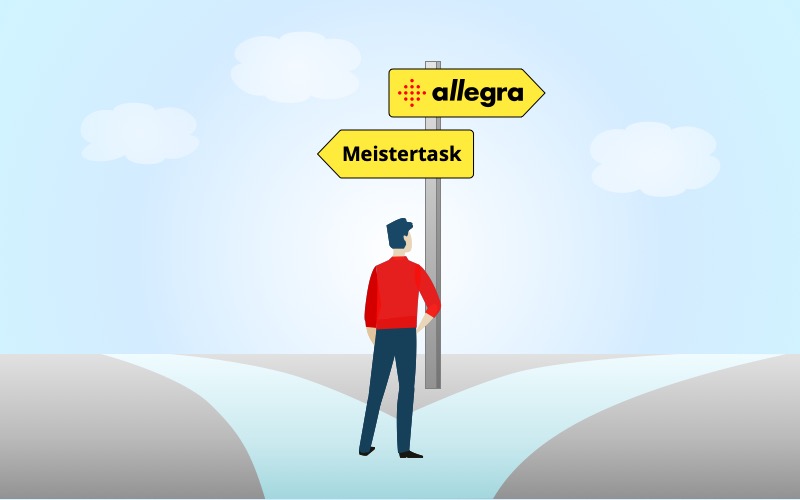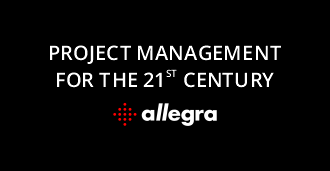Meistertask Alternative: Is Allegra Better for You?
Overview
If you’re looking for an alternative to Meistertask, then Allegra might be the best choice for you. In this article, I am going to present you Allegra’s main features as a project and task management tool. Allegra is functional, customizable, and can comprehensively address your needs.
Before we start, we have to keep in mind that Meistertask is essentially a task management system and, like Trello, does not claim to be a complete project management tool.
1. General Functions: Meistertask and Allegra
Hoasting
Meistertask is available exclusively as a cloud solution. Alternatively, you can run Allegra on premises or as Software as a Service (SaaS) in the cloud.
Both Meistertask and Allegra guarantee compliance with European data protection standards. Your data is located exclusively in the EU with both of these products.
Projects and Project Types
With Allegra, you manage tasks in projects or work areas. Areas have a certain type, which allows you to configure central settings for all areas of this type. You can also create templates for projects or areas.
In Meistertask, you can copy projects, but you cannot create templates or reconfigure projects centrally.
Processes and Process Types
In task and project management, almost everything revolves around processes.
Processes, like projects, can have a certain type that influences the behavior of corresponding tasks in Allegra. Examples of process types include: tasks, action items, and problem reports. You can also create custom process types.
You can give process types their own workflows and attributes. This means that you can control how things need to be done depending on the process’s type. For example, an action item has an optional deadline, whereas a task has a mandatory start and end date.
Task Hierarchies
Allegra supports hierarchical tasks to any depth, which also creates functional dependencies. For example, a task cannot be closed if its subordinate tasks are still open. Correspondingly, you can’t set the finish date of a subordinate task after the finish date of a superior task. You can restrict the type of subordinate operations depending on the type of the superior operation.
Here’s an example: We want to sell a car, but we need to fix the engine first. In order for us to prevent the subordination of a superior task, such as “car sale”, we can distinguish that “engine repair” is subordinate to “car sale” in Allegra. We don’t want to sell a car before we fix the engine. That’d be a bad deal. Even though repairing the engine is, in a sense, less important than selling the car, we still have to do it before we sell the car.
Notifications
Allegra has a sophisticated, extensively configurable notification system. If you want to send your manager a task update tomorrow at 1:34pm, you can do that easily with Allegra.
Email notifications are based on customizable templates. There is an @ function as well as a reminder function.
For example, if your teammate completes a task and then reopens it, the notification system can send emails only to the manager of the affected task.
Access Authorization
Access rights are granted in Allegra on a role-based and project-specific basis. You can grant permissions for:
- an entire project or workspace
- task types such as tasks, open items, or problem reports
- individual attributes, such as the budget for an activity
The authorization system allows you to control very precisely who can see or change something.
You can define your own roles with corresponding authorizations.
Attributes
In Allegra, you can configure custom attributes without programming via its web interface.
Allegra provides you with extensive selection of attribute types, such as labels, person selection, or date fields. In addition, you can customize the behavior of default attributes in a meaningful way. For example, you have the opportunity to tailor a default value for a start or end date to your needs.
You can also create a selection list field that displays all users who belong to a certain group.
Different presets can be configured for the attributes for different projects.
Input Masks
Any number of input masks can be defined in Allegra. You can structure them with tabs and panels.
You can assign an input mask when you create new task and then a different one for subsequent editing.
Defining different input masks for the same activity type in different areas or projects is also possible.
Dependencies
In project and task management, tasks are often related to one another. For example, a task cannot be started until another one has been completed. Or a task cannot be closed until a dependent task has been completed.
Alternatively to Meistertask, Allegra gives you extensive support for defining dependencies or links. The most important link types, like end-start relationships or duplications, are available after installation. You can define other ones, too, if you’d like.
Allegra is also compatible with plug-ins.
With Meistertask, you can only define task relationships as related, duplicate, or blocking.
Cockpits
Project management software offers its users an overview page, also known as a dashboard or cockpit.
Each user has the option of using preconfigured cockpits or creating their own cockpit from an extensive list of cockpit tiles. You can save cockpits as templates. System administrators can then centrally assign cockpits to other users.
Here’s some, but not all, cockpit elements that Allegra provides you:
- Average response time
- Average processing time
- Number of activities in state (x) over time
- Activity stream
- Predefined filters
Reporting Functions
You can issue reports in Allegra based on report templates or with a direct export to Excel or as a PDF. Report templates are easily customizable. If you prefer exporting to Word or HTML instead of Excel or as a PDF, you can do that, too!
User Management
You can connect Allegra LDAP system to manage users. You can synchronize users and groups with an LDAP server manually or automatically.
If you’d like, you can also connect multiple directory servers.
Allegra integrates with CAS for true single sign-on. It also supports two-factor authentication.
User Interface and Operability
Allegra offers a nice, tidy and modern-looking user interface. The average user will pick it up quickly, even without training. Just in case you run into trouble, we provide context-sensitive help if something is not obvious.
For configuration, you have to get familiar with the basic concepts of Allegra. For this purpose, you can find material in the form of tutorials, videos, slide sets, and user manuals on our website. We also offer training courses if you prefer hands-on instruction.
Allegra user interfaces can be customized to meet the needs of our users. For each user or user group, the available menu items can be configured individually.
Interfaces and Expandability
Through an extensive REST interface, almost all functions are accessible in Allegra that are also offered at the user interface. For example, users can be managed, projects can be created, modified and deleted or queries can be executed.
2. Task Management
Delegation
Allegra supports the delegation of tasks including resubmission. The delegator keeps the relationship to the task and the resubmission date is his personal one. The delegator has an overview of the tasks he has delegated.
Deputy Function
In Allegra, you can assign a deputy, aka a backup person, to each user. If someone is ill or on vacation, the deputy can take over the rights of the original user and act in his or her place. You can still see who does what.
Recurring Tasks
Some tasks and appointments repeat cyclically, e.g. every first Monday of the month. Handling such series of tasks can be very helpful and time-saving in task management.
Allegra allows you to create repeating tasks, just like you are used to with any good calendar application.
Time Tracking
Allegra allows to keep track of expenses (time and money) for each operation and assign them to accounts. Accounts can be grouped into cost centers and shared for projects.
There is a possibility to use timers in the application to automatically record the time spent. Reports give an overview of who was busy with which activities in any past period.
Support of the Getting Things Done Method
The Getting Things Done method is an excellent practice for personal work organization. It allows personal categorization of tasks, such as personal resubmission appointments or personal marking of tasks as favorites.
Allegra fully supports the GTD method.
Support of the RACI matrix
For task management and project management, the RACI method defines four task-specific roles through which project participants can relate to a task. Normally, one assigns roles for a project, but not for an activity. For example, there is one project manager or one scrum master for the entire project. RACI, on the other hand, allows us to assign roles on an activity-specific basis.
Allegra is one of the few systems on the market that has integrated the RACI matrix into its application logic and offers it in such a way that its practical benefits are immediate.
Workflows
Task management systems usually map workflows in two forms. The first method always refers to the workflow of an operation that passes through various stations. The second method is to define sets of tasks and then process them.
Allegra supports both methods. There is a graphical workflow editor for task-related workflows. With the help of area templates and collective tasks, even very complex, extensive workflows can be easily created in the form of task packages.
3. Project Management
Programs and Portfolios
In many organizations, projects run as part of programs, portfolios or product areas. One must be able to group these together in order to maintain an overview.
Besides grouping, a basic requirement for program or portfolio management is the ability to arrange them hierarchically.
Allegra allows you to arrange areas hierarchically as deep as desired and thus supports a simple, pragmatic program and portfolio management.
Sub-projects
One can’t sufficiently structure larger project plans by just hierarchizing tasks. Rather, one has to be able to split these projects into sub-projects. Sub-projects may require different processes, e.g. for hardware and software development.
Allegra allows you to structure projects hierarchically as deep as you’d like. The different sub-projects can be assigned their own project types with appropriate adaptation to the specific sub-processes. This also allows hybrid projects to be realized, i.e. mixtures of classic and agile project management.
Multi-project reports
All queries and reports can span multiple projects and sub-projects, which can be freely defined by appropriate filters.
Work Breakdown Structure
Before one can create a project plan, one has to structure tasks that need to be done or and establish the project’s results. To represent such a project structure, also known as a Work Breakdown Structure (WBS), activities must be able to be arranged hierarchically at any depth.
In Allegra, you can completely represent a WBS. The order of operations can be freely defined at any level.
Interactive Gantt Charts
Gantt charts help to define and display the timing of project activities as well as predecessor-successor relationships. Allegra offers a powerful interactive Gantt component. It’s possible to display a critical path. There are project progress bars. One can also compare a current plan status to a baseline plan.
Resource Planning
Resources of different types can be managed and assigned to tasks. Allegra provides us a window that displays resource utilization over time. You can also immediately see overloads and underloads. Resources can be sorted by project or department affiliation.
Employee Availability
There is a personal calendar for each employee, which shows the availability. Allegra takes availability into account during resource planning.
Project Progress
Project progress can be displayed in Allegra in three differently precise and elaborate ways:
- via the number of tasks already completed in relation to the total task quantity
- with regard to the status of tasks and degree of completion
- via the earned value method
The last method requires keeping track of the actual effort expended. To do this, one obtains a very reliable, conservative estimate of current and future plan variance. Progress and plan deviations are presented in corresponding diagrams in a clear and understandable manner.
Agile Project Management
Allegra completely supports agile project management methods, such as Scrum and Kanban. It doesn’t only provide us task boards or burn charts. Allegra also offers you the tools such as epics, user stories, backlogs, and sprints.
Backlog priority, sprint capacity, and team velocity are supported by appropriate application logic. Tasks left over from a previous sprint can be automatically carried over to the next sprint. Allegra can automatically create Sprints in advance.
For software developers, there are integrations with source code management systems such as Git and Subversion, as well as CI/CD servers such as Gitlab and Jenkins.
Conclusion
If you and your team are in need of a project management software that is highly customizable and supports the most important project and task management tools, then Allegra may be a great alternative for you! If you’re curious about other project management tools, please take a look at our article on the best project management software in 2021.




